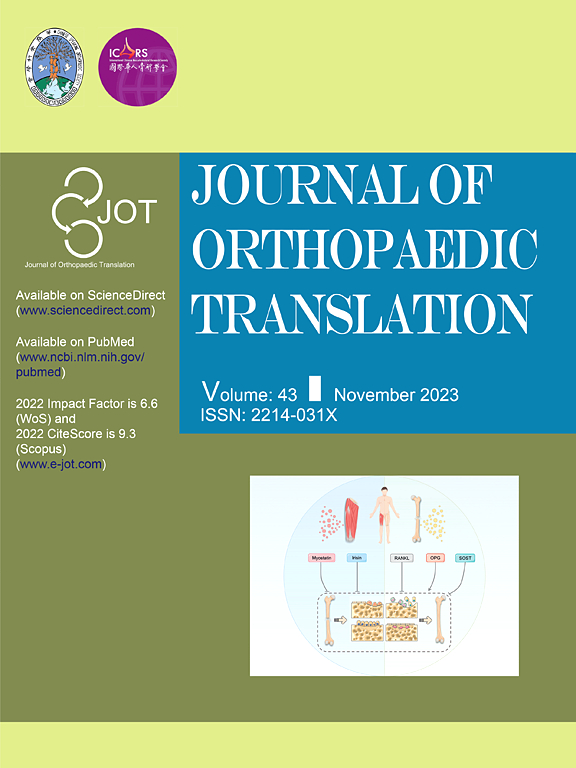慢性运动神经元激活促进臂丛神经损伤后轴突再生和功能恢复
IF 5.9
1区 医学
Q1 ORTHOPEDICS
引用次数: 0
摘要
臂丛神经损伤(brachial plexus injury, BPI)会导致上肢运动功能的显著损害,主要是由于轴突再生速度缓慢导致无神经支配的肌肉进行性萎缩。因此,确定加速轴突延伸的策略至关重要。方法建立臂丛神经损伤小鼠模型,采用化学发生方法特异性激活C6脊髓运动神经元。然后,我们通过行为测试、形态学分析和电生理检测来评估损伤小鼠的轴突再生和运动功能恢复。结果AAV9-hM3Dq病毒能有效转导运动神经元,CNO能有效激活体内成熟的hM3Dq+运动神经元。慢性化学发生激活可显著促进腹根挤压损伤脊髓运动神经元的再生,加速轴突延伸,改善轴突再髓鞘形成,导致轴突大小增加。这种激活还促进了成人运动神经元中新神经肌肉连接(NMJs)的形成,并减少了肌肉萎缩。此外,它促进了运动单元的电生理恢复,改善了整体运动功能。结论成体运动神经元的化学发生激活可显著促进轴突生长,介导更好的行为恢复。这些发现强调了化学发生神经元激活在促进神经损伤后功能恢复方面的治疗潜力。我们建立了一种慢性化学发生方法,激活臂丛神经损伤后的hM3Dq+运动神经元,加速轴突再生,增强功能恢复。这一策略有望成为治疗神经系统损伤的临床治疗方法。本文章由计算机程序翻译,如有差异,请以英文原文为准。

Chronic motoneuronal activation enhanced axonal regeneration and functional recovery after brachial plexus injury
Background
Brachial plexus injury (BPI) leads to significant impairment of upper limb motor function, primarily due to progressive atrophy of denervated muscles resulting from the slow rate of axonal regeneration. Therefore, identifying strategies to accelerate axon extension is of critical importance.
Methods
In this study, we first established a mouse model of brachial plexus injury and employed chemogenetic approaches to specifically activate C6 spinal motoneurons. We then assessed axonal regeneration and motor function recovery in the injured mice through behavioral tests, morphological analyses, and electrophysiological detection.
Results
We found that the AAV9-hM3Dq virus efficiently transduced motoneurons, and CNO administration robustly activated mature hM3Dq+ motoneurons in vivo. Chronic chemogenetic activation significantly enhanced the regeneration of spinal motoneurons injured by ventral root crush, accelerated axon extension, and improved axonal remyelination, resulting in increased axon size. This activation also facilitated the formation of new neuromuscular junctions (NMJs) in adult motoneurons and reduced muscle atrophy. Furthermore, it promoted electrophysiological recovery of the motor unit and improved overall motor function.
Conclusion
Chemogenetic activation of adult motoneurons can robustly enhances axon growth and mediate better behavioral recovery. These findings highlight the therapeutic potential of chemogenetic neuronal activation in promoting functional recovery following nerve injury.
The translational potential of this article
We have established a chronic chemogenetic method to activate hM3Dq+ motor neurons after brachial plexus injury, which accelerates axonal regeneration and enhances functional recovery. This strategy holds promise as a clinical therapeutic approach for treating nervous system injuries.
求助全文
通过发布文献求助,成功后即可免费获取论文全文。
去求助
来源期刊

Journal of Orthopaedic Translation
Medicine-Orthopedics and Sports Medicine
CiteScore
11.80
自引率
13.60%
发文量
91
审稿时长
29 days
期刊介绍:
The Journal of Orthopaedic Translation (JOT) is the official peer-reviewed, open access journal of the Chinese Speaking Orthopaedic Society (CSOS) and the International Chinese Musculoskeletal Research Society (ICMRS). It is published quarterly, in January, April, July and October, by Elsevier.
 求助内容:
求助内容: 应助结果提醒方式:
应助结果提醒方式:


